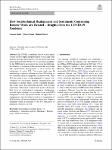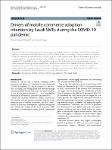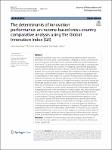Search
Author
- Marina, Dabić (3)
- Christa, Sys (2)
- Domingo, Ribeiro-Soriano (2)
- Gittell, Ross (2)
- next >
Subject
- kinh tế (26)
- Economics (12)
- Management science (7)
- Development Economics (6)
- next >
Date issued
- 2020 - 2023 (306)
- 2010 - 2019 (47)
- 2009 - 2009 (1)
Has File(s)
- true (354)
Search Results
Autonomous vehicle advancements and communication technologies such as V2V, V2I, and V2X have enabled the development of connected and autonomous vehicles. Because CAVs are directly effective in traffic, their application in traffic management and incident management appears promising. They can immediately begin regulating traffic and acting as sensors due to their connectivity to the infrastructure. This research proposes Incident Detection Included Linear Management (IDILIM), a CAV-based incident management algorithm that regulates CAV and traffic speeds based on dynamic and predicted shockwave speeds. The SUMO simulations are carried out on a 10.4-km-long, three-lane facility with 21 sensors every 500 m. In the scenarios, three traffic demands, eleven CAV penetration rates, and v... |
The COVID-19 pandemic forced sociotechnical systems (STS) to highly integrate remote work. Large-scale analyses show that the positivity of tweets about work from home decreased until COVID-19 was declared a pandemic by the WHO and re-increased in the weeks that followed. Nevertheless, it is unclear if this reaction is due to personal and organizational developments or if it mirrors the realignment of entire STS. The present study uses Q methodology to identify differences in how STS realign to the externally enforced integration of remote work. Only STS that reach a state of high alignment to remote work conditions by successfully shifting communication and procedures to digital spheres can be considered resilient. The results show that employees describe their personal experiences... |
Technology entrepreneurship and corporate innovation are important for the development of indigenous innovation. In the digital age, founders are subject to fundamental changes in their strategy choices, which in turn affect corporate innovation performance. This paper aims to explore the strategic choices adopted by technical founders of listed companies in China’s STAR market to reap the rewards of innovation in a digital context. Based on the annual reports of 124 listed companies in China’s STAR Market, this paper applies machine learning methods to quantify digital transformation of enterprises, and empirically analyzes the relationship between technical founders and innovation performance by constructing a moderated mediating model. |
We examine the connectedness of the COVID vaccination with the economic policy uncertainty, oil, bonds, and sectoral equity markets in the US within time and frequency domain. The wavelet-based findings show the positive impact of COVID vaccination on the oil and sector indices over various frequency scales and periods. The vaccination is evidenced to lead the oil and sectoral equity markets. More specifically, we document strong connectedness of vaccinations with communication services, financials, health care, industrials, information technology (IT) and real estate equity sectors. However, weak interactions exist within the vaccination–IT-services and vaccination–utilities pairs. Moreover, the effect of vaccination on the Treasury bond index is negative, whereas the economic poli... |
Grounded in the technology-organization-environment framework, this paper investigates critical drivers of mobile commerce (m-commerce) adoption intention by SMEs in Saudi Arabia, a developing country in transition, during the COVID-19 pandemic. A quantitative approach was adopted in this study for data collection and analysis. A proposed research model was tested and validated using PLS-SEM on data collected using a structured questionnaire from a sample of 171 Saudi SMEs located in the capital city of Riyadh. The findings reveal that top management support, environmental uncertainty and perceived benefits are the critical drivers of m-commerce adoption intention. However, perceived costs do not influence firms’ intentions to adopt m-commerce. |
The direct effects of technology transfer and innovation on the productivity and competitiveness of economies and businesses are well established. However, research is yet to establish the explanatory variables and the boundary conditions within which these relationships exist. This study examines the extent to which product quality mediates the relationship between technology transfer and competitiveness of small-scale agricultural businesses (SSABs). Moreover, the study explores the extent to which the geographical location moderates the technology transfer–business competitiveness relationship, including whether asset value moderates the product quality–competitiveness relationship. A cross-sectional survey was conducted on 400 SSAB owners and managers in the Free State and Masho... |
Determining which ports to call at in a maritime loop is considered as an important determinant factor for shipping companies which impacts not only on efficiency, and productivity but also on transportation costs. The port selection process becomes more challenging and sensitive if the market is for perishable goods such as fruits and vegetables. Specifically, this paper aims to develop an efficient maritime supply chain for reefer cargo. A case study of refrigerated cargo trade between West-Africa and West-Europe is investigated for which the main objective is to minimize the trade route's supply chain costs. To do so, the paper analyzes various scenarios based upon the different types of cargo (transshipment and non-transshipment), commodity types (dry and reefer), and a combinat... |
Social innovation has increasingly become an issue of policy and particularly given the policy focus on societal grand challenges. As anchor institutions, the challenge for entrepreneurial universities is to effectively respond and contribute to both technological and social innovation through knowledge and technology transfer. The current conceptualization of entrepreneurial universities is predominately focused on technological innovation. This paper argues for a mission-reorientation of entrepreneurial universities that extends the current technological innovation based conceptualization to incorporate social innovation that effectively addresses environmental and societal challenges and responds to calls in the society for more sustainable and inclusive growth. |
The manufacturing domain is regarded as one of the most important engineering areas. Recently, smart manufacturing merges the use of sensors, intelligent controls, and software to manage each stage in the manufacturing lifecycle. Additionally, the increasing use of point clouds to model real products and machining tools in a virtual space facilitates the more accurate monitoring of the end-to-end production lifecycle. Thus, the conjunction of both, intelligent methods and more accurate 3D models allows the prediction of uncertainties and anomalies in the manufacturing process as well as reduces the final production costs. However, the high complexity of the geometrical structures defined by point clouds and the high accuracy required by the Quality Assurance/Quality control paramete... |
Despite the dearth of research on innovation, the key determinants of innovation performance still need to be clarified. Besides, a comparative analysis of the determinants of innovation performance across countries at different income levels has yet to be found. This study, therefore, aims to bridge this research gap by considering the innovation performance of 63 countries. Participating countries were purposefully selected from the Global Innovation Index (GII) dataset. Multistage and multimodal analyses were conducted, including multiple linear regressions, hierarchical regression, and ANOVA, to examine the variation in innovation performance and pinpoint critical determinants in each category of countries. The result reveals that human capital, research, infrastructure, and bus... |










